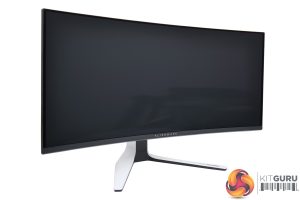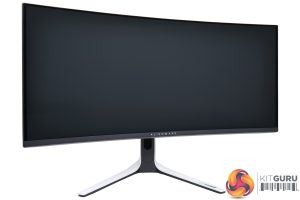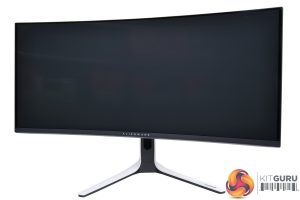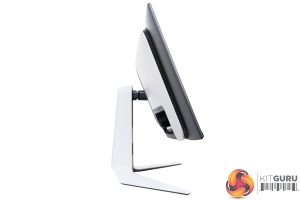Starting things off with a look at the design of the Alienware AW3423DW, its overall aesthetic is very much in keeping with other Alienware monitors released over the last year or so. Starting at the front, we find a sleek ‘bezel-less' design, with a bottom chin that measures about 1.5cm thick.
The rear of the display is a bit more eye-catching, with matte white plastic panels covering most of the stand and the back of the screen. Those give it a clean-looking two-tone appearance, though you obviously don't see most of the white sections when actually using the display.
We do also find the inclusion of RGB lighting, with an oval-shaped LED strip running around the stand. A small Alienware logo is positioned to the left of this, which is another RGB zone.
The included stand offers a good amount of ergonomic adjustment too, including up to 110mm of height adjust, 40 degrees of swivel both left and right, as well as tilt from -5 to +21 degrees. There's no pivot or rotational abilities however, but I don't see that as a big loss due to the size and 1800R curve of the screen.
My one gripe with the stand is the overall depth of it – the display measures about 30cm from front to back, so it's fairly thick and will sit a bit further forward on your desk as a result. Still, it is possible to switch the stand out for a custom VESA 100×100 mount if you prefer, with the depth of just the monitor itself (minus the stand) coming in at about 13cm.
The I/O is neatly tucked away in a recessed panel on the back of the screen. We find 1x DisplayPort 1.4, and then 2x HDMI 2.0. That means no HDMI 2.1, something we understand is due to the use of a hardware G-Sync module which still doesn't support HDMI 2.1. While the DisplayPort 1.4 connector can offer the full 175Hz refresh rate at the 3440×1440 resolution, the HDMI 2.0 ports will be limited to 120Hz, so it is a bit disappointing to have only one video input which can make full advantage of the refresh rate on offer.
There's also a USB upstream port and two USB 3.2 Gen1 downstream ports, but no Type-C.
On the underside of the front bezel, two more USB ports are positioned for easy access as well as a 3.5mm jack. This is also where we find the small joystick used for controlling the OSD.
 KitGuru KitGuru.net – Tech News | Hardware News | Hardware Reviews | IOS | Mobile | Gaming | Graphics Cards
KitGuru KitGuru.net – Tech News | Hardware News | Hardware Reviews | IOS | Mobile | Gaming | Graphics Cards

















